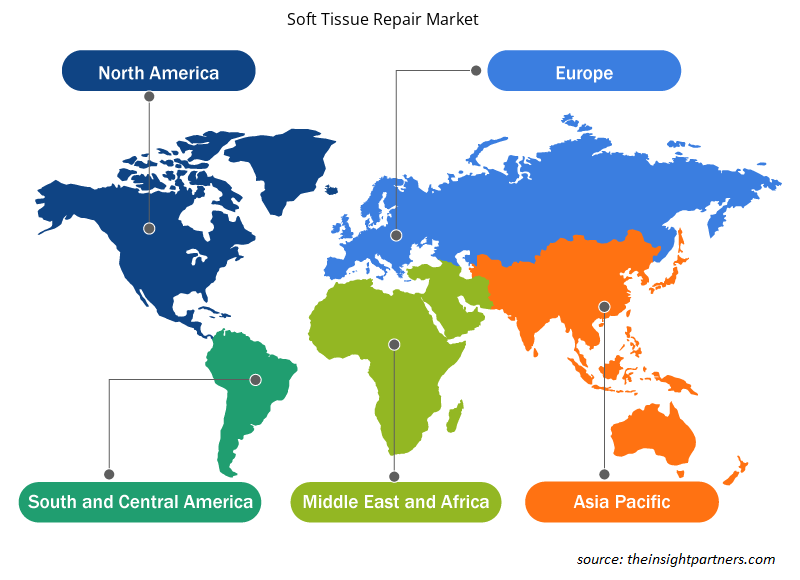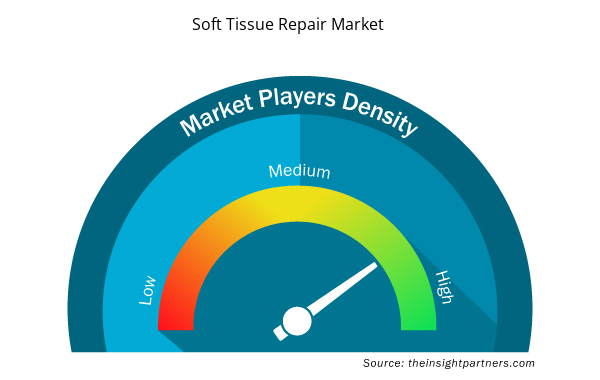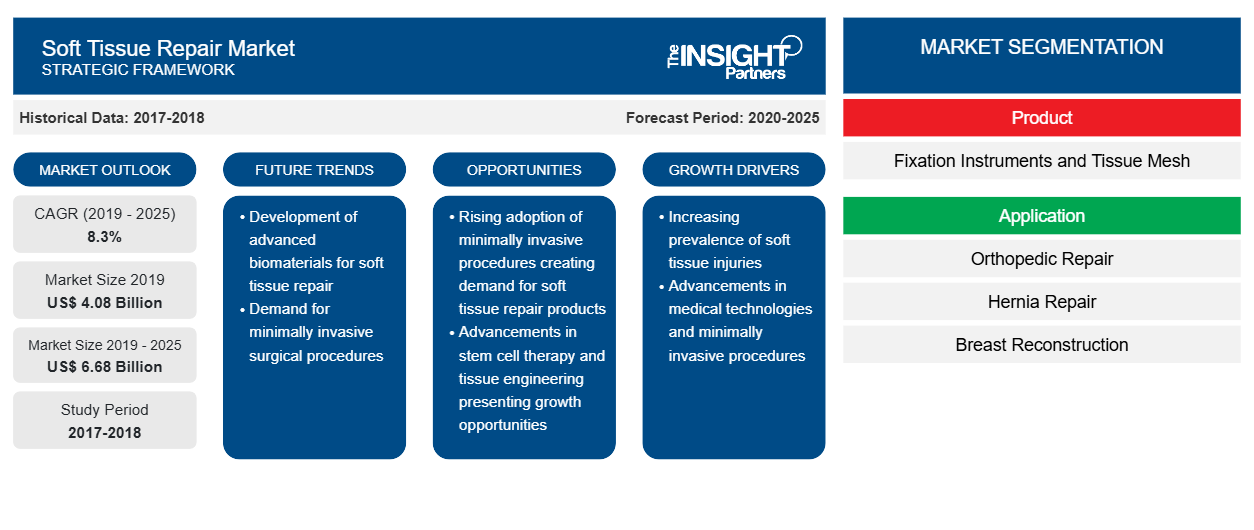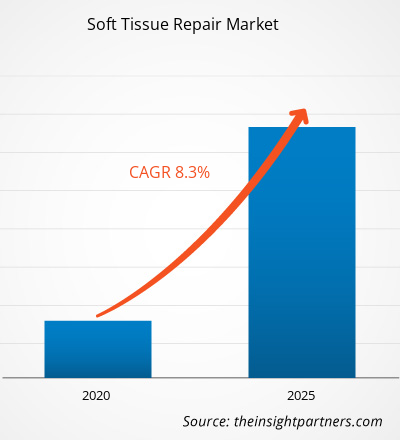[研究报告] 软组织修复市场规模预计将从 2019 年的 40.762 亿美元增长到 2025 年的 66.77 亿美元;预计 2020 年至 2025 年的复合年增长率为 8.3%。
分析师观点
预计在预测期内,人口老龄化和运动损伤将以惊人的速度增长。软组织损伤可能发生在体育运动和锻炼活动中,有时日常活动也会导致这些损伤。软组织修复是指使用各种医疗器械再生和重建软组织的一系列程序。全球老年人口的增加正在增加骨科软组织修复程序的使用。人们对此类损伤的认识提高以及公司推出软组织修复产品的努力预计将促进全球软组织修复市场的增长。2022 年 5 月,Paragon 28, Inc. 推出了 Grappler 缝合锚系统,以应对在急性足部和踝关节手术中进行软组织张紧和韧带重建时出现的挑战。此外,高度先进的医疗设施和高昂的医疗费用正在推动各个地区软组织修复市场的增长。
市场概况
皮肤、肌腱和韧带、关节滑膜组织、血管、淋巴管、周围神经、肌肉、神经和血管是人体中的各种软组织。拉伤、肌肉和/或肌腱拉伸或撕裂、韧带撕裂或拉伸、挫伤或擦伤、肌腱炎和滑囊炎是运动员和运动员中最常见的常见软组织损伤。软组织修复涉及使用固定装置和组织网或贴片。缝合线、缝合锚和干涉螺钉是用于软组织固定的一些固定装置。合成网、同种异体移植物和异种移植物也用于替换身体各个部位丢失的软组织。由于成人和儿童软组织损伤数量增加以及医院提供紧急治疗,对软组织修复器械的需求增加。软组织修复市场的主要驱动因素是运动损伤发生率的增加和骨科手术数量的增加。此外,对运动医学 和软组织损伤的日益关注也促进了软组织修复市场的增长。
定制此报告以满足您的需求
您可以免费定制任何报告,包括本报告的部分内容、国家级分析、Excel 数据包,以及为初创企业和大学提供优惠和折扣
- 获取此报告的关键市场趋势。这个免费样品将包括数据分析,从市场趋势到估计和预测。
市场驱动因素
运动损伤患病率上升推动全球软组织修复市场增长
儿童、成人和老年人群中软组织损伤的数量有所增加。运动员中软组织损伤也很常见,可能需要立即治疗。疾病控制和预防中心 (CDC) 表示,参加体育运动的成人和青少年数量有所增加。根据约翰霍普金斯大学的数据,运动损伤在从事各种体育活动(如足球、篮球、足球、冰球和其他游戏以及田径运动)的成人和儿童中很常见。扭伤和拉伤、膝盖损伤、肌腱损伤、骨折、脱臼和肩袖损伤是一些常见的运动损伤。
由于参加体育运动的成年人越来越多,运动损伤的患病率也在上升。政府组织开展调查,以确定特定领域需要解决的常见运动损伤数量。根据国家安全委员会的数据,5-14 岁的儿童占所有足球伤害的 50%、足球伤害的 45% 和棒球伤害的 44%。足球造成的伤害最多,2018-19 年每年约有 455,449 例。在因足球而遭受的所有膝盖损伤中,最常见的是前交叉韧带 (ACL) 断裂。同年,足球造成了约 412,607 人受伤(包括男性和女性球员);估计其中 22% 的伤害是脑震荡。2021 年,近 57,600 例运动相关伤害是脑震荡。此外,2021 年约有 320 万人因涉及运动和娱乐设备的伤害在急诊室接受治疗。
篮球和足球等接触性运动的运动损伤发生率较高,因为这些运动涉及接触和碰撞,导致关节、骨骼、肌腱和其他软组织严重受伤。此类伤害需要紧急治疗,甚至需要手术。根据 ValuePenguin 的研究数据,2021 年急诊室治疗了超过 440 万例与篮球相关的伤害。其次,足球是导致伤害的第二大常见运动,造成 330 万人受伤,占所有运动相关伤害的 20%。根据美国骨科医师学会的估计。美国每年报告 200,000 例 ACL 损伤,每年进行约 100,000 例 ACL 重建。因此,与运动相关的软组织损伤数量正在增加,这反过来又推动了软组织修复市场的增长。
节段分析
根据产品,软组织修复市场细分为固定器械和组织网/补片。2019 年,固定器械部分占据了软组织修复市场的较大份额。此外,预计同一部分在预测期内的复合年增长率会更高。在软组织修复过程中,各种固定装置用于将软组织固定在解剖结构(例如骨骼)的表面,骨骼比软组织具有更高的强度和刚度。缝合线、缝合锚、干涉螺钉等是各种骨科手术中使用的主要固定装置类型。这些装置使医生能够在手术过程中保持组织张力。固定器械部分细分为缝合锚、干涉螺钉、缝合线等。缝合锚部分在 2019 年占据了最大的市场份额,预计在预测期内的复合年增长率最高。缝合锚用于软组织固定,尤其是在关节镜和疝气修复手术期间。现在,新近上市的、技术先进的锚用于修复和优化肌肉骨骼组织,例如髋部、膝盖、手、肘部、足部和踝部。缝合锚有助于软组织与骨骼的愈合,因为由于骨骼上的软组织数量不足,无法进行软组织与软组织的直接修复。此外,软组织修复市场上的各种缝合锚可提供牢固且更好的固定效果。无结缝合锚有助于将软组织固定到骨骼等刚性结构上。锚的内构件接收缝合线并在外管构件内旋转。由于锚的内膜旋转,缝合线缠绕在内构件上。外管膜对所连接的线施加压力,以保持线在内膜上的位置,从而实现组织缝合。
区域分析
2019 年北美软组织修复市场价值为 17.915 亿美元,预计到 2025 年将达到 29.946 亿美元;预计预测期内的复合年增长率为 8.7%。北美软组织修复市场分为美国、加拿大和墨西哥。2019 年,美国占据北美软组织修复市场的最大份额。美国软组织修复市场的增长主要得益于生物制剂在软组织修复和疝气修复等骨科手术中的使用增加。在美国,同种异体移植主要用于组织修复,因为外科医生普遍倾向于使用同种异体移植。根据 Ortho Regenerative Technologies 的数据,美国每年进行近 600,000 例肩袖手术。根据美国运动医学骨科协会的数据,美国每年有近 100,000 至 250,000 例 ACL 断裂。此外,组织损伤也受到高度重视,导致运动员对软组织损伤及其治疗的认识不断提高。此外,乳腺癌在美国女性中也很普遍。根据 breastcancer.org 的数据,在美国,近八分之一的女性(约 12.4%)在其一生中会患上浸润性乳腺癌。截至 2022 年 1 月,美国有超过 380 万女性患有乳腺癌。根据美国整形外科医师协会 (ASPS)/整形外科基金会 2020 年的数据,2018 年美国约有 101,600 名女性接受了乳房重建。
此外,新产品的推出和研究资金也推动了美国软组织修复市场的增长。例如,2022 年 11 月,Novadip Biosciences 在 B 轮股权融资和非稀释性融资中额外筹集了 4103 万美元(4000 万欧元)。这笔资金加速了 Novadip 的两种研究性脂肪干细胞 (ASC) 衍生组织再生产品的临床开发:NVD-X3 和 NVD-003。因此,上述因素预计将推动北美地区软组织修复市场的增长。
关键球员分析
软组织修复市场分析包括以下参与者:Smith & Nephew;Depuy Synthes;Covidien (Medtronic);Wright Medical Group, Inc.;CR Bard, Inc.;Arthrex, Inc.;Integra Lifesciences Corporation;Organogenesis;Stryker;和 ConMed。在软组织修复市场的参与者中,Depuy Synthes 和 Arthrex, Inc 是排名前两位的参与者,因为它们提供的产品组合多样化。
软组织修复市场区域洞察
Insight Partners 的分析师已详尽解释了预测期内影响软组织修复市场的区域趋势和因素。本节还讨论了北美、欧洲、亚太地区、中东和非洲以及南美和中美洲的软组织修复市场细分和地理位置。

- 获取软组织修复市场的区域特定数据
软组织修复市场报告范围
| 报告属性 | 细节 |
|---|---|
| 2019 年市场规模 | 40.8亿美元 |
| 2025 年市场规模 | 66.8亿美元 |
| 全球复合年增长率(2019 - 2025) | 8.3% |
| 史料 | 2017-2018 |
| 预测期 | 2020-2025 |
| 涵盖的领域 | 按产品
|
| 覆盖地区和国家 | 北美
|
| 市场领导者和主要公司简介 |
|
软组织修复市场参与者密度:了解其对业务动态的影响
软组织修复市场正在快速增长,这得益于终端用户需求的不断增长,而这些需求又源于消费者偏好的不断变化、技术进步以及对产品优势的认识不断提高等因素。随着需求的增加,企业正在扩大其产品范围,进行创新以满足消费者的需求,并利用新兴趋势,从而进一步推动市场增长。
市场参与者密度是指在特定市场或行业内运营的企业或公司的分布情况。它表明在给定市场空间中,相对于其规模或总市场价值,有多少竞争对手(市场参与者)存在。
在软组织修复市场运营的主要公司有:
- 施乐辉
- 德普合成公司
- Arthrex 公司
- 美敦力
- Integra 生命科学公司
免责声明:上面列出的公司没有按照任何特定顺序排列。

- 了解软组织修复市场顶级关键参与者概况
最新动态
软组织修复市场中的公司普遍采用并购等无机和有机战略。以下列出了一些近期的关键市场发展:
- 2023 年 1 月,Arthrex 的 ACL TightRope 植入物获得美国食品药品监督管理局 (FDA) 的儿科适应症批准。TightRope 植入物用于骨科损伤的外科治疗,是首个也是唯一一个获得儿科批准的 ACL 损伤固定装置。
- 2022 年 8 月,CONMED Corporation 完成了对私人控股的 Biorez, Inc(一家专注于利用其专有的 BioBrace 植入技术促进软组织愈合的医疗设备初创公司)的收购。BioBrace 植入物是一种创新的生物诱导支架,旨在加固软组织并促进愈合。此次收购以 8500 万美元的现金对价完成,并在四年内额外支付高达 1.65 亿美元的基于增长的盈利支付。
- 2021 年 9 月,史赛克创伤与四肢部门推出了 Citrelock 肌腱固定装置系统,通过采用名为 Citregen 的可吸收技术的肌腱线为外科医生提供差异化设计。
- 2021 年 7 月,BD 收购了 Tepha, Inc.,后者是一家领先的专有可吸收聚合物技术开发商和制造商。Tepha 的聚 4-羟基丁酸 P4HB 技术平台提供了额外的创新潜力,加速了 BD 手术网片产品组合的增长,并推动公司进入软组织修复、重建和再生领域的潜在新领域。
- 历史分析(2 年)、基准年、预测(7 年)及复合年增长率
- PEST 和 SWOT 分析
- 市场规模价值/数量 - 全球、区域、国家
- 行业和竞争格局
- Excel 数据集


- Hummus Market
- Aesthetic Medical Devices Market
- Maritime Analytics Market
- 3D Mapping and Modelling Market
- Online Exam Proctoring Market
- Airline Ancillary Services Market
- Electronic Signature Software Market
- Data Center Cooling Market
- Machine Condition Monitoring Market
- Nuclear Decommissioning Services Market

Report Coverage
Revenue forecast, Company Analysis, Industry landscape, Growth factors, and Trends

Segment Covered
This text is related
to segments covered.

Regional Scope
North America, Europe, Asia Pacific, Middle East & Africa, South & Central America

Country Scope
This text is related
to country scope.
常见问题
Suture anchor, Suture, and interference screw are among the devices used for soft tissue fixation. Artificial mesh, allograft, and xenograft also are accustomed replace the lost soft tissue in numerous components of the body.
Based on product, the soft tissue repair market is divided into fixed instruments and tissue patch. The tissue mesh section would account for a bigger market share in 2021
The availability of alternatives for soft tissue repair and lack of awareness regarding soft tissue injuries hamper the market growth.
The high prevalence of Diabetes Mellitus makes the healing of soft tissue injuries troublesome among geriatric population.
Factors like increasing range of orthopedic procedures, rising prevalence of sport injuries, and surge in geriatric population are sustain the soft tissue repair market growth.
Trends and growth analysis reports related to Life Sciences : READ MORE..
The List of Companies - Soft Tissue Repair Market
- Smith & Nephew
- DePuy Synthes
- Arthrex, Inc.
- Medtronic
- Integra Lifesciences Corporation
- Stryker Corporation
- BD
- Organogenesis Inc.
- Allergan Plc.
- W. L. Gore and Associates, Inc.
- Cook Medical LLC
- B. Braun Melsungen AG
- DSM
- Baxter International Inc.
The Insight Partners performs research in 4 major stages: Data Collection & Secondary Research, Primary Research, Data Analysis and Data Triangulation & Final Review.
- Data Collection and Secondary Research:
As a market research and consulting firm operating from a decade, we have published and advised several client across the globe. First step for any study will start with an assessment of currently available data and insights from existing reports. Further, historical and current market information is collected from Investor Presentations, Annual Reports, SEC Filings, etc., and other information related to company’s performance and market positioning are gathered from Paid Databases (Factiva, Hoovers, and Reuters) and various other publications available in public domain.
Several associations trade associates, technical forums, institutes, societies and organization are accessed to gain technical as well as market related insights through their publications such as research papers, blogs and press releases related to the studies are referred to get cues about the market. Further, white papers, journals, magazines, and other news articles published in last 3 years are scrutinized and analyzed to understand the current market trends.
- Primary Research:
The primarily interview analysis comprise of data obtained from industry participants interview and answers to survey questions gathered by in-house primary team.
For primary research, interviews are conducted with industry experts/CEOs/Marketing Managers/VPs/Subject Matter Experts from both demand and supply side to get a 360-degree view of the market. The primary team conducts several interviews based on the complexity of the markets to understand the various market trends and dynamics which makes research more credible and precise.
A typical research interview fulfils the following functions:
- Provides first-hand information on the market size, market trends, growth trends, competitive landscape, and outlook
- Validates and strengthens in-house secondary research findings
- Develops the analysis team’s expertise and market understanding
Primary research involves email interactions and telephone interviews for each market, category, segment, and sub-segment across geographies. The participants who typically take part in such a process include, but are not limited to:
- Industry participants: VPs, business development managers, market intelligence managers and national sales managers
- Outside experts: Valuation experts, research analysts and key opinion leaders specializing in the electronics and semiconductor industry.
Below is the breakup of our primary respondents by company, designation, and region:

Once we receive the confirmation from primary research sources or primary respondents, we finalize the base year market estimation and forecast the data as per the macroeconomic and microeconomic factors assessed during data collection.
- Data Analysis:
Once data is validated through both secondary as well as primary respondents, we finalize the market estimations by hypothesis formulation and factor analysis at regional and country level.
- Macro-Economic Factor Analysis:
We analyse macroeconomic indicators such the gross domestic product (GDP), increase in the demand for goods and services across industries, technological advancement, regional economic growth, governmental policies, the influence of COVID-19, PEST analysis, and other aspects. This analysis aids in setting benchmarks for various nations/regions and approximating market splits. Additionally, the general trend of the aforementioned components aid in determining the market's development possibilities.
- Country Level Data:
Various factors that are especially aligned to the country are taken into account to determine the market size for a certain area and country, including the presence of vendors, such as headquarters and offices, the country's GDP, demand patterns, and industry growth. To comprehend the market dynamics for the nation, a number of growth variables, inhibitors, application areas, and current market trends are researched. The aforementioned elements aid in determining the country's overall market's growth potential.
- Company Profile:
The “Table of Contents” is formulated by listing and analyzing more than 25 - 30 companies operating in the market ecosystem across geographies. However, we profile only 10 companies as a standard practice in our syndicate reports. These 10 companies comprise leading, emerging, and regional players. Nonetheless, our analysis is not restricted to the 10 listed companies, we also analyze other companies present in the market to develop a holistic view and understand the prevailing trends. The “Company Profiles” section in the report covers key facts, business description, products & services, financial information, SWOT analysis, and key developments. The financial information presented is extracted from the annual reports and official documents of the publicly listed companies. Upon collecting the information for the sections of respective companies, we verify them via various primary sources and then compile the data in respective company profiles. The company level information helps us in deriving the base number as well as in forecasting the market size.
- Developing Base Number:
Aggregation of sales statistics (2020-2022) and macro-economic factor, and other secondary and primary research insights are utilized to arrive at base number and related market shares for 2022. The data gaps are identified in this step and relevant market data is analyzed, collected from paid primary interviews or databases. On finalizing the base year market size, forecasts are developed on the basis of macro-economic, industry and market growth factors and company level analysis.
- Data Triangulation and Final Review:
The market findings and base year market size calculations are validated from supply as well as demand side. Demand side validations are based on macro-economic factor analysis and benchmarks for respective regions and countries. In case of supply side validations, revenues of major companies are estimated (in case not available) based on industry benchmark, approximate number of employees, product portfolio, and primary interviews revenues are gathered. Further revenue from target product/service segment is assessed to avoid overshooting of market statistics. In case of heavy deviations between supply and demand side values, all thes steps are repeated to achieve synchronization.
We follow an iterative model, wherein we share our research findings with Subject Matter Experts (SME’s) and Key Opinion Leaders (KOLs) until consensus view of the market is not formulated – this model negates any drastic deviation in the opinions of experts. Only validated and universally acceptable research findings are quoted in our reports.
We have important check points that we use to validate our research findings – which we call – data triangulation, where we validate the information, we generate from secondary sources with primary interviews and then we re-validate with our internal data bases and Subject matter experts. This comprehensive model enables us to deliver high quality, reliable data in shortest possible time.


 获取此报告的免费样本
获取此报告的免费样本